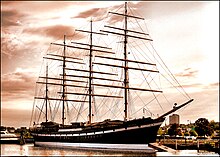Moshulu
Moshulu arrived in Queenstown (Cobh, Ireland) on 10 June 1939, after 91 days at sea, winning the last race of square-rigged sailing ships between Australia and Europe.
She was derigged step-by-step in the 1940s, and, after having capsized in a storm close to shore at a beach in Østervik near Narvik in 1947, she was demasted by a salvaging company to be re-erected, stabilized, and towed to Bergen in July 1948.
Then she was sold to the German shipowner Heinz Schliewen, who wanted to put her back to use under the name Oplag as a merchant marine training ship carrying cargo.
In 1953 Moshulu was sold to the Swedish Farmers' State Union (Svenska Lantmännens Riksförbund) of Stockholm, and again it was used as a floating warehouse beginning on 16 November 1953.
In 1961, the Finnish government bought the ship for 3,200 tons of Russian rye; she was towed to Naantali, a town near Turku, and she continued to be used as a grain warehouse.
In 1970, the ship was bought by the Specialty Restaurants Corporation, who rigged her out at Scheveningen in the Netherlands with replica masts, yards, and lines and towed her to South Street Seaport Museum, New York.
[2] The United States Coast Guard 3rd District Band rode on the Moshulu as she was towed from Brooklyn to the museum and played for the arrival ceremony on the Manhattan side of the river.
At the age of 18 he was apprenticed aboard the Moshulu, joining the ship in Belfast in 1938 and sailing to Port Lincoln in Australia with a load of ballast stone in 82 days, a good passage for a windjammer.
In the 1974 American film, The Godfather Part II, the ship plays the role of the vessel that brought the boy Vito Andolini across the Atlantic from Sicily to New York in 1901.
